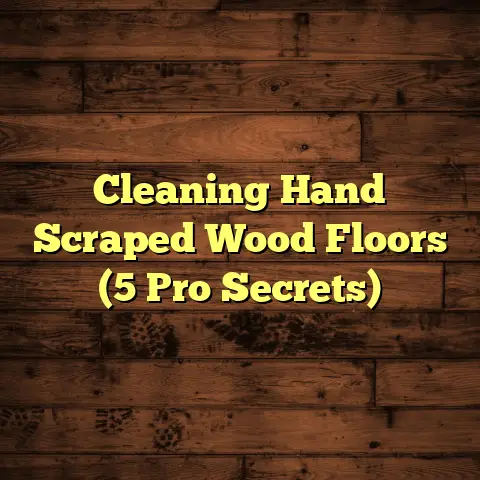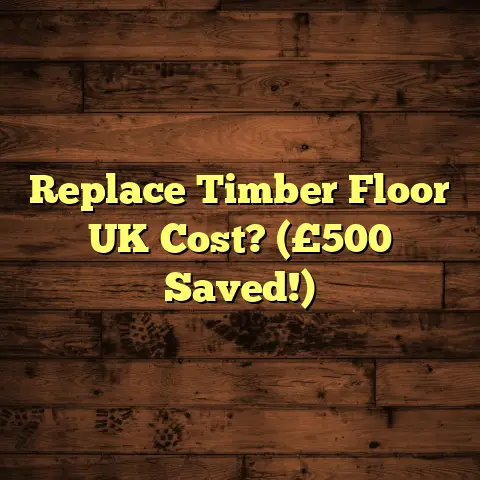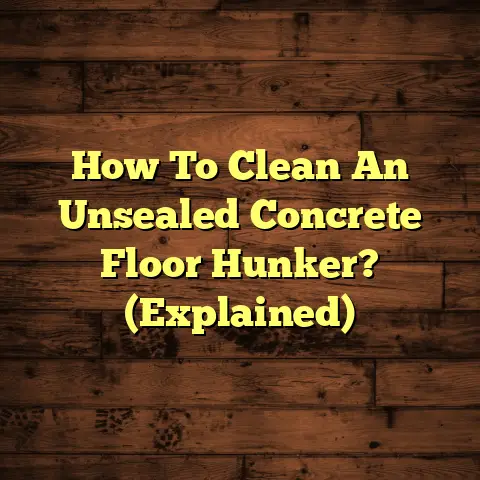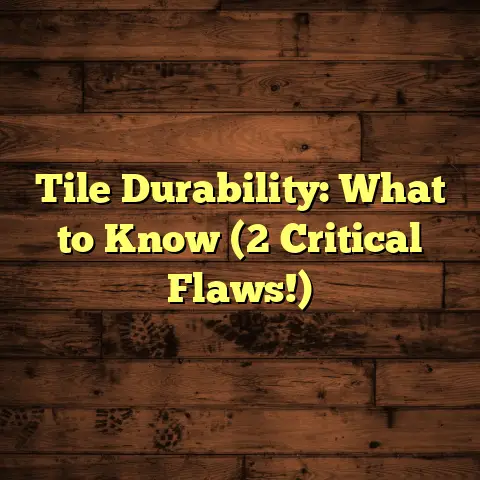Does Vinyl Plank Need A Vapor Barrier? (Explained)
When I first stepped into the world of flooring, I quickly learned that choosing the right materials and installation methods was essential for long-lasting results.
With vinyl plank flooring gaining popularity for its aesthetic appeal and durability, many homeowners often ask: “Does vinyl plank need a vapor barrier?” My journey through numerous projects has provided me with insights into this question, along with some valuable lessons that I’m excited to share.
Understanding Vapor Barriers
A vapor barrier is a crucial component in flooring installations, designed to prevent moisture from penetrating through floors and causing damage.
While many people are familiar with the concept, the need for a vapor barrier can vary significantly based on several factors.
The Importance of Moisture Control
Moisture control plays a vital role in the longevity and performance of flooring materials.
Vinyl plank flooring, while resistant to water, is not entirely immune to moisture problems.
Here’s where my understanding deepened over the years:
- Moisture Sources: Moisture can originate from various sources: groundwater, humidity in the air, or even plumbing leaks.
Identifying these sources is critical in determining whether a vapor barrier is necessary. - Effects of Moisture: Over time, excessive moisture can lead to mold growth, warping, and deterioration of the flooring material.
I’ve seen firsthand how neglecting moisture control can result in costly repairs.
Personal Experiences
Throughout my career as a flooring contractor, I’ve encountered a range of environments and conditions.
Here’s a deeper exploration of my experiences with vinyl plank installations in different settings:
Project 1: Denver’s Dry Climate
In Denver, I worked on a beautiful residential home where the air was dry, and humidity levels rarely exceeded 30%.
The homeowners wanted vinyl plank flooring for their living room and kitchen.
Given the climate conditions, I opted not to use a vapor barrier.
- Outcome: The installation went smoothly.
With no vapor barrier needed, the process was straightforward, and the clients were thrilled with the final look of their new flooring.
Even years later during a follow-up visit, the flooring remained intact and pristine.
Project 2: New Orleans’ Humid Environment
Contrastingly, my experience in New Orleans was quite different.
Here, I was called to install vinyl plank flooring in a basement that had persistent humidity issues.
The homeowner had previously faced serious mold problems due to moisture seeping up from the ground.
- Vapor Barrier Decision: For this project, I recommended using a vapor barrier.
We laid down 6-mil polyethylene sheeting before starting the installation process. - Outcome: The results were impressive.
The homeowner reported that they felt more at ease knowing they had an additional layer of protection against moisture.
After several months, there were no signs of warping or mold—proof that our precautions paid off.
The Installation Process
When installing vinyl plank flooring with a vapor barrier, I’ve developed a structured approach to ensure success:
Step 1: Assessing Moisture Levels
Before any installation begins, I always assess the moisture levels of the subfloor.
For this, I use a moisture meter to gauge dampness accurately.
- Ideal Moisture Levels: Ideally, moisture levels should be below 12% for wood subfloors and under 4% for concrete slabs.
If levels exceed these thresholds, it may be wise to consider additional moisture control measures.
Step 2: Preparing the Subfloor
The pre-installation phase is crucial. Here’s what I do:
- Cleaning: I ensure that the subfloor is free from dust, debris, or old adhesive residues.
- Repairing: Any damage must be fixed before laying down the vapor barrier.
A smooth surface is vital for proper adhesion. - Leveling: If there are any uneven areas, I use leveling compounds to create a flat surface.
Step 3: Installing the Vapor Barrier
Once the subfloor is prepared:
- Roll Out the Barrier: I unroll the polyethylene sheeting across the entire area.
- Overlap Seams: Ensuring that seams overlap by at least six inches prevents any moisture from sneaking through.
- Seal Edges: I use tape to secure all seams and edges properly.
This step is essential for creating an airtight seal.
Step 4: Installing Vinyl Plank Flooring
With the vapor barrier in place, I proceed with laying down the vinyl plank flooring:
- Start in One Corner: I usually begin in one corner of the room and work my way outward.
- Locking Mechanism: Many vinyl planks feature a locking mechanism that makes installations easier.
- Leave Expansion Gaps: To accommodate expansion due to temperature changes, I always leave a small gap (around 1/4 inch) near walls and fixed objects.
Cost Considerations
Understanding costs is vital in any flooring project.
The inclusion of a vapor barrier can influence your budget significantly.
Here’s how I approach cost estimation using FloorTally:
- Material Costs: Using FloorTally allows me to input local material prices for both vinyl planks and vapor barriers accurately.
For instance, in New Orleans, I estimated around $0.50 per square foot for the vapor barrier material itself. - Labor Costs: Labor costs can also vary based on whether a vapor barrier is included.
In humid areas where we need to lay down a barrier, labor might increase slightly due to the additional steps involved. - Overall Budgeting: By providing clients with detailed estimates generated through FloorTally, they can see how each component affects their overall budget.
This transparency helps them feel secure in their decisions.
Successes and Challenges
Every project brings its own successes and challenges.
Here’s a more detailed look at both aspects in relation to using vapor barriers:
Successes
- Long-Term Performance: Projects where I used vapor barriers in high-moisture environments have consistently shown better long-term performance compared to those without barriers.
- Client Satisfaction: Homeowners appreciate knowing they have taken proactive measures against potential moisture issues.
Many have expressed relief when they see their floors remain intact after heavy rains or seasonal humidity spikes.
Challenges
- Resistance to Additional Costs: Some clients initially balk at the idea of an added expense for a vapor barrier.
It often requires explaining how it can save them money over time by preventing damage. - Installation Errors: Not properly sealing seams or overlaps can lead to moisture issues later on.
I’ve encountered situations where clients attempted DIY installations without adequate knowledge of vapor barriers, resulting in problems down the line.
Practical Tips for Homeowners
Here are some practical tips based on my experiences that homeowners can apply when considering vinyl plank flooring installations:
- Evaluate Your Environment: Take note of your local climate and any existing moisture problems in your home.
- Conduct Moisture Tests: Use a moisture meter on your subfloor before installation; this can save headaches later.
- Be Prepared for Costs: Factor in all potential costs when budgeting for your project—this includes materials like vapor barriers along with labor.
- Choose Quality Materials: Opt for high-quality vapor barriers that are thick enough (6-mil or more) to be effective against moisture intrusion.
- Hire Professionals When Needed: If you’re unsure about the installation process or assessing moisture levels, it’s wise to consult with experienced contractors.
Comparing Options
While vinyl plank flooring is a popular choice due to its versatility and appearance, there are other options available that might suit specific needs better:
Laminate Flooring
- Moisture Resistance: Laminate flooring typically requires similar considerations when it comes to moisture control but may not perform as well as vinyl in high-moisture areas.
- Cost Factor: Laminate tends to be less expensive than vinyl plank but may require more frequent replacements if exposed to excess moisture.
Tile Flooring
- Durability: Tile is waterproof and doesn’t require a vapor barrier; however, it can be cold and hard underfoot compared to vinyl.
- Installation Complexity: Tile installation typically takes longer and may require professional help for best results.
Conclusion
The question of whether vinyl plank needs a vapor barrier ultimately depends on various factors including environmental conditions, subfloor material, and specific project requirements.
My experiences have led me to conclude that using a vapor barrier can provide peace of mind and protect flooring investments in areas prone to moisture issues.
By thoroughly assessing your situation, making informed decisions, and following best practices during installation, you can ensure your vinyl plank flooring remains beautiful and functional for years to come.
Whether you choose to include a vapor barrier or not, understanding your unique needs will help you make choices that will benefit your home long-term—because at the end of the day, it’s all about creating spaces that you love and that stand the test of time.





